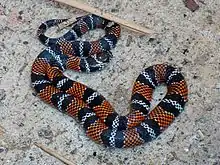Erythrolamprus bizona
Erythrolamprus bizona, commonly known as the double-banded false coral snake, is a species of colubrid snake, which is endemic to northern South America and Central America.
| Erythrolamprus bizona | |
|---|---|
 | |
| false coral snake | |
| Scientific classification | |
| Kingdom: | Animalia |
| Phylum: | Chordata |
| Class: | Reptilia |
| Order: | Squamata |
| Suborder: | Serpentes |
| Family: | Colubridae |
| Genus: | Erythrolamprus |
| Species: | E. bizona |
| Binomial name | |
| Erythrolamprus bizona | |
| Synonyms | |
Geographic range
It is found in Colombia, Venezuela,[3] Costa Rica, Nicaragua, Panama,[2] and on the island of Trinidad (in the Republic of Trinidad and Tobago).
Mimicry
Similar in pattern to a coral snake, this species probably gains protection through mimicry.
Diet
It probably feeds mainly on other snakes.
Habitat
It is often found in the leaf litter or burrowed in the soil in rain forests.
Symbiotic relationship
It burrows primarily near the Pouteria caimito, commonly known as the abiu, a tropical fruit tree, the nutrients of which supply the snake's clutch of eggs. In turn the tree is fertilized by the snake's urine and embryotic fluid.
References
- ITIS (Integrated taxonomic Information System). www.itis.gov.
- The Reptile Database. www.reptile-database.org.
- Freiberg, M.A. 1982. Snakes of South America. T.F.H. Publications. Hong Kong. 189 pp. ISBN 0-87666-912-7. (Erythrolamprus bizona, p. 98.)
Further reading
- Boos, Hans E.A. (2001). The Snakes of Trinidad and Tobago. Texas A&M University Press. College Station, Texas. xvi + 328 pp. ISBN 1-58544-116-3.
- Goldberg, Stephen R. (2004). "Notes on reproduction in the false coral snakes, Erythrolamprus bizona and Erythrolamprus mimus (Serpentes: Colubridae) from Costa Rica". The Texas Journal of Science. Texas Academy of Science. 56 (2): 171–174.
- Jan G. 1863. Enumerazione sistematica degli ofidi appartenenti al gruppo Coronellidae. Arch. Zool. Anat.Fisiol. 2 (2): 213–330. (Erythrolamprus aesculapii [var.] bizona, pp. 314–316.)